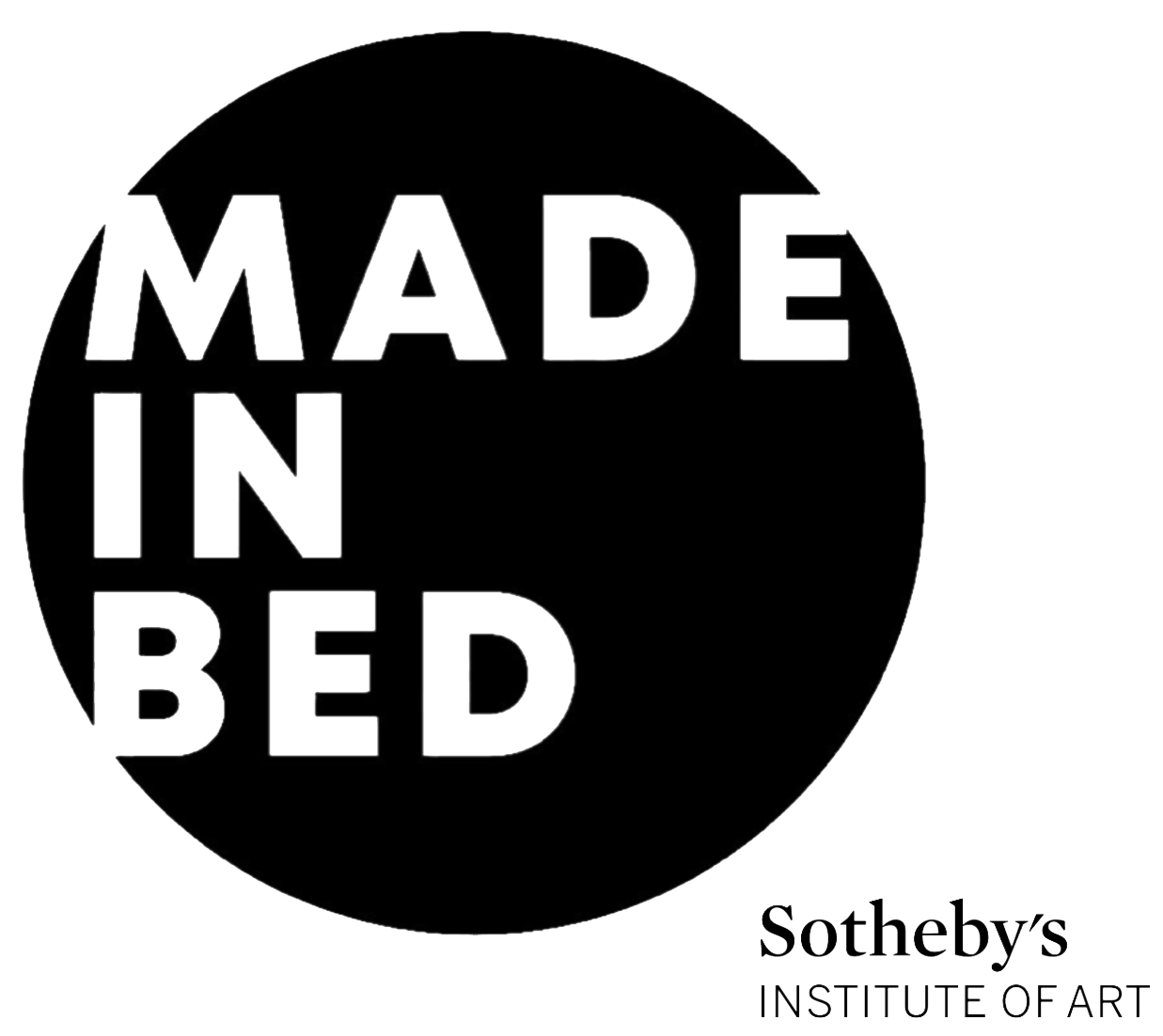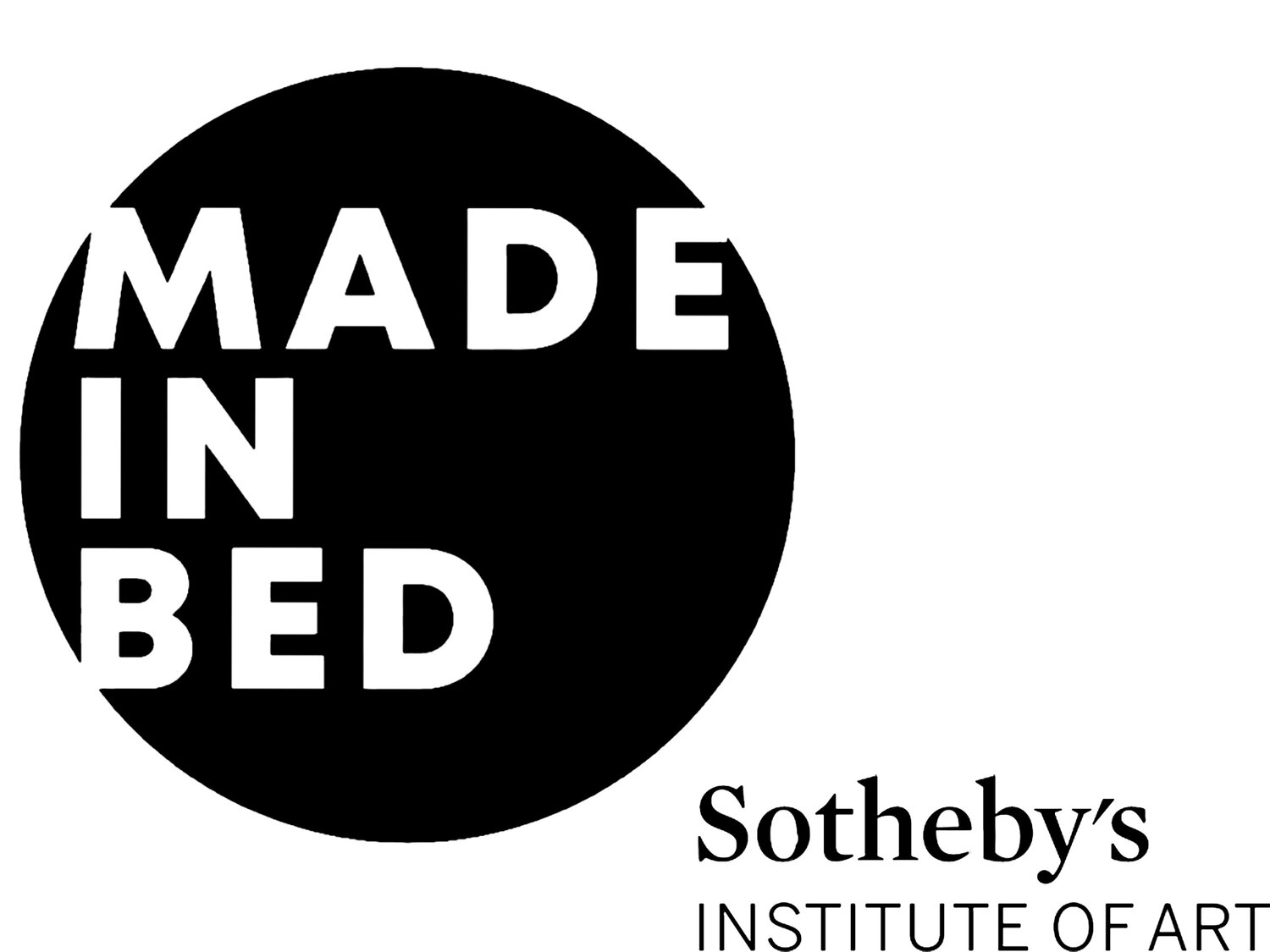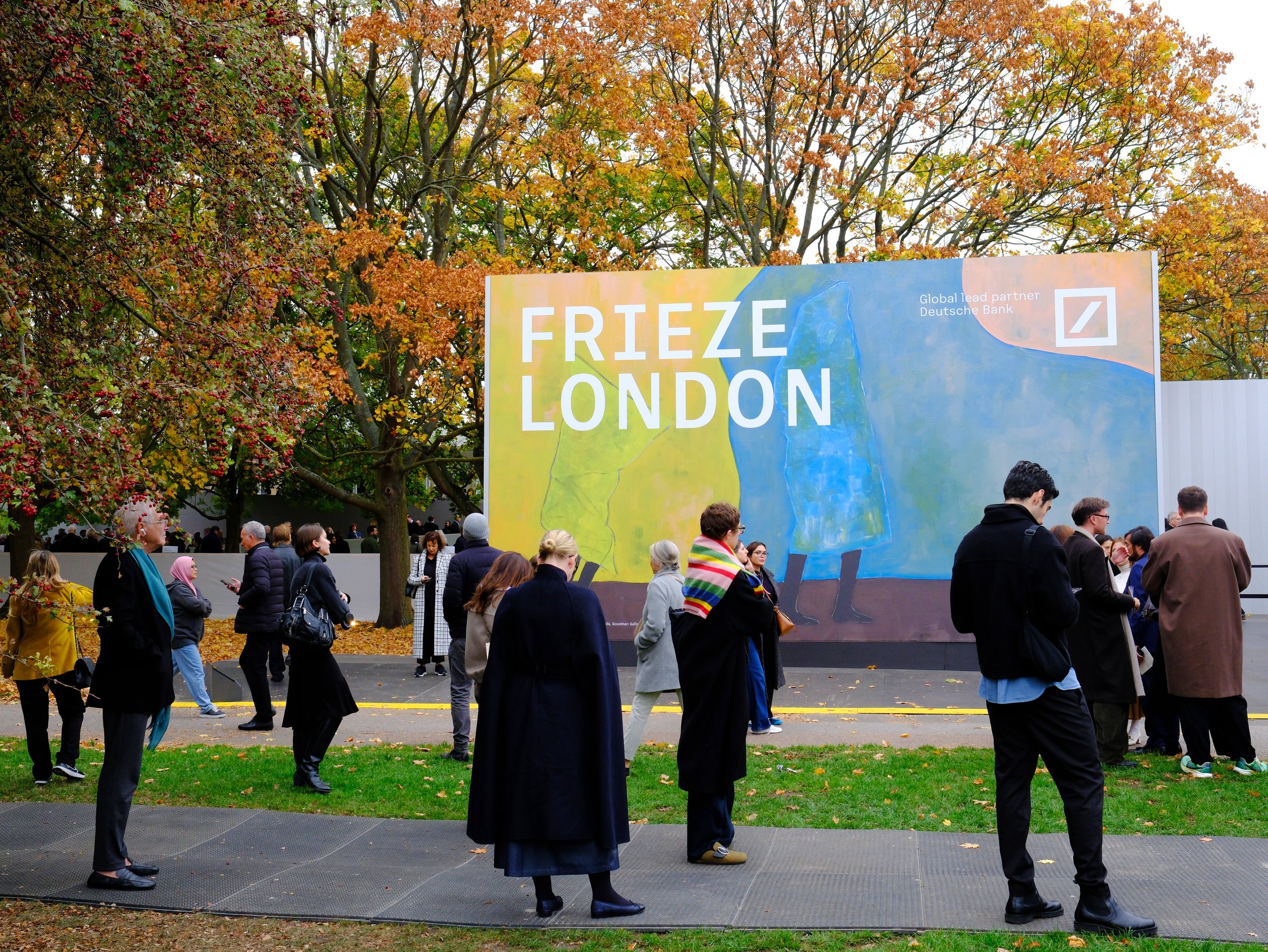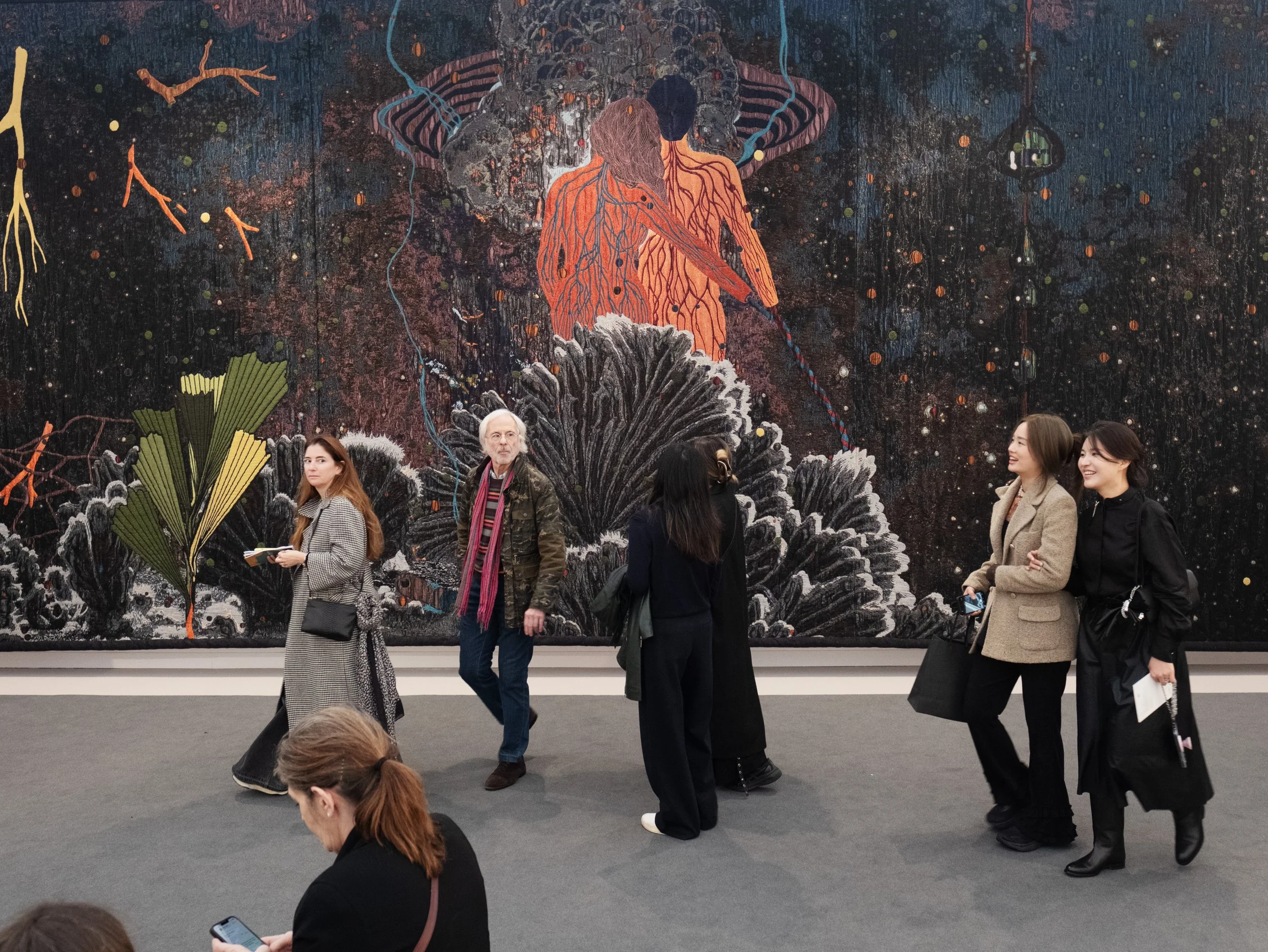London Isn’t Lost: Frieze 2025 and Beyond
It is easy to fall into the headlines: the art market is contracting, London is losing its shine, and Paris is quietly positioning itself as the new center of European collecting, or is it Milan? or Basel? Never mind; it will soon change again. The truth is, walking through Frieze London and Frieze Masters last week, those headlines fell apart. Reality is always more nuanced. Yes, the market is adjusting, dealers are cautious, and collectors are selective, but beneath any semblance of pragmatism, there was movement, energy, and genuine excitement around the art on display.
Frieze London 2025. Photo courtesy: Frieze.
Across Regent’s Park, the aisles were alive with a steady flow of collectors, curators and enthusiasts. Several galleries reported early sales; some were pleasantly surprised by new buyers, while others were too busy to comment, a reminder that the fair is as much about transactions as it is a spectacle for seeing and being seen. The word discount was overheard, a small nod to the adjustments galleries are making in a market that remains weary of risk. Yet the air was one of determination: a collective sense that while caution might prevail, the delicate act of showing, selling, and collecting continues. Art remains of interest, of value, and despite the odds, a sound investment.
As Margaret Carrigan at Artnet observed, the $200k range remained the “sweet spot” for many galleries, though plenty of works moved for less. Pace reported numerous sales on the first day of William Monk’s work at up to $295k, while Proyectos Ultravioleta sold out its works by Johanna Unzueta at the $10-15k mark. These figures show a market still active across multiple tiers, rewarding both established names and emerging artists. At booth A3, Cecilia Brunson sold out the majority of the stand’s solo presentation of Claudia Alarcón & Silät work within the first hour of the fair. An incredible feat, and welcome surprise accompanying the artist’s increasing visibility in the international art scene. With new collectors from the UK, Europe, Singapore and North America taking notice, London seems to hold the world in its hands for one autumn week.
At Frieze Masters, accessible price points drew in new buyers, as more established connoisseurs were on the lookout for the missing puzzle pieces for their collections. Colnaghi and Elliot Fine Art were reported to sell eleven works on the first day, including two drawings by Surrealist Leonor Fini for around $26k each, a rare opportunity for those interested in historical female artists. The fair was not without big names, from Andy Warhol to Odilon Redon, and everything in between. Moira Sims, Director of New York-based Anat Ebgi, displayed contentment with her first participation in Frieze London after having participated for years in Frieze LA. Their decision of taking on London alongside numerous newcomers makes one thing clear: the London market is still running and galleries want to be a part of it.
Almeida and Dale x Travesia Cuatro, Frieze Masters 2025. Photo by Hugo Glendinning, Courtesy of Frieze.
From the eyecatching works of An Te Liu to historic voices across the park, Frieze formed a symphony of diversity worthy of its audience. A larger presence of women artists was a happy surprise, as was the variety of formats presented by blue-chip galleries, extending beyond the expected monumental works. From Surrealists to contemporary voices, the works of Vanessa Raw, Paula Rego, Eleonore Koch, Helena Almeida, March Avery, Sonja Sekula, Remedios Varo and Leonora Carrington coexisted with a clear intent, to recuperate long-ignored perspective and renew the art historical cannon.
Florence Ingleby of Ingleby Gallery, Edinburgh, called into question the doom and gloom press narrative, as well as the talk of Paris being the new epicentre for the arts. The gallery’s success was evident, with the stunning works by Mia Kokkoni and Caroline Walker anchoring its booth. “We are having a great time”, she said, noting how the London-Paris comparison now feels increasingly irrelevant. Galleries, collectors, and institutions appear to operate in a complementary rather than competitive rhythm: Sadie Coles recently opened up a new space in London, while Waddington Custot plans a new Paris venue in the coming months. These parallel developments underscore the idea that European art hubs operate as interconnected nodes, each enhancing the other.
The social and cultural rhythm of the week was unmistakable. Hans Ulrich Obrist moved through the fair with his characteristic curiosity, scanning stands in search of the next big promise. Simon de Pury glided by in his iconic blue suit. Larry Gagosian hosted an opening surrounded by the up and coming young generation of gallerinas. Auctioneers, advisors, and dealers drifted between Frieze, Mayfair openings, private events and auction previews, a living emblem of the city’s interconnected market, with classical, contemporary, and experimental spheres overlapping in real time.
Lisson Gallery, Frieze London 2025. Photo by Linda Nylind. Courtesy of Frieze.
International attendance was robust, German, Italian, French, Portuguese and Spanish were frequently overheard, with German and Italian speakers being particularly prominent. Whether they were actively purchasing or scouting, their numbers underscored London’s enduring appeal to European collectors, despite the logistical complexities of Brexit. The city remains a central hub for the continent, with a strong pull for institutions and collectors alike. Even the weather failed to dampen the turnout. Despite the rain on Sunday, crowds persisted, a visible testament to London’s magnetism and the enduring commitment of its audience.
London’s art ecosystem, however, is not limited to Regent’s Park. Other fairs, such as 1:54, Minor Attractions, and the new female-led Echo Soho offered counterpoints to the renowned tent, bringing together emerging galleries, experimental presentations, and playful formats. U-Haul Gallery exemplified an alternative model: a mobile exhibition space parked in between Frieze London and Frieze Masters posed a challenge to the traditional models. A rolling challenging reminder of the capacity for innovation that art and creatives hold. Other pop-ups and temporary installations activated spaces far and wide across the city. Among these was “Letters from Home” at 309 in Bethnal Green, curated by Mora Pranteda and Federika Chaimowicz, which featured a series of paintings and works on paper by Benito Ekmekdjian, alongside a sound contribution by Weston Olencki. Demonstrating how the city can be transformed through the will of younger curators and emerging arts professionals who carve out their own space during Frieze Week and make their voices known. Where there is a will there is a way.
The coexistence of diverse projects alongside Frieze, be they high profile, polished, white cube evening events, or bohemian openings at underground spaces with a taste of studio 54. The intersection between Blue-Chip gallery presentations and pop-ups, resulted in a city wide tapestry that offered collectors, enthusiasts and curious visitors a range of experiences for every taste. London’s art scene felt fully alive, a space of coexistence for emerging voices, historical names and experimental approaches where the end result is mutual strengthening.
Esther Schipper, Frieze London 2025. Photo by Linda Nylind. Courtesy of Frieze.
The week also came with the news of the art market’s continued international expansion. The announcement of Frieze Abu Dhabi, pointed to strategic diversification rather than contraction. A small Abu Dhabi Art lounge at Frieze London offered a hint of what is to come, while signaling that London remains central to a broader, global network of collectors and fairs. Meanwhile, auction results further reinforced market resilience. Christie’s and Sotheby’s evening sales achieved solid totals, bolstering confidence. Hauser & Wirth reported multiple transactions in the millions, proof that time-tested artists maintain value and that a buyer’s market does not preclude confidence or investment.
Despite the market’s complex nature, there was a prevailing sense of optimism. Dealers were pragmatic rather than panicked, and collectors seemed ready to engage with works they value rather than reacting solely to the headlines. There was a quiet determination on behalf of many galleries, focused on working, selling and sustaining London’s relevance in a complex global art landscape.
In short, Frieze Week 2025 was not just about transactions, but rather witnessing resilience, a sense of community, and affirming London’s undeniable role in the art world. Across fairs, pop-ups, openings, performances, auctions and events of all sorts, the city displayed a breath of activity that remains unmatched. A reminder that London is far from lost, and its art scene is very much alive, adaptive and endlessly inspiring.
Carolina Zemma
Contributing Writer, MADE IN BED





